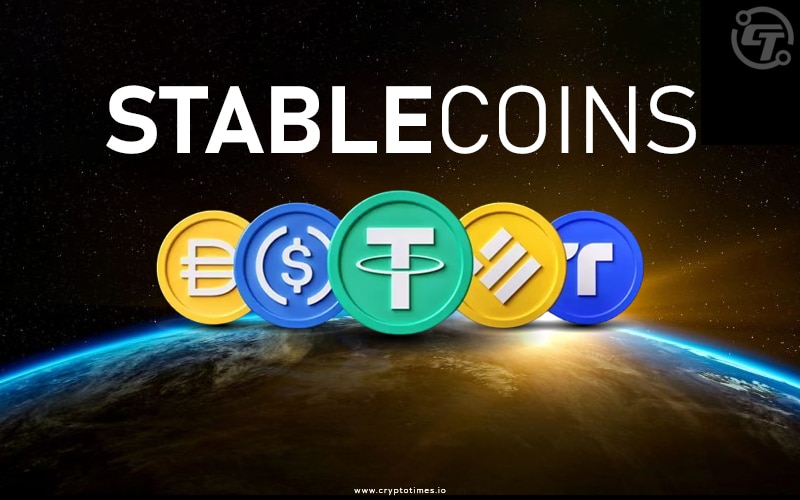Stablecoins- you’ve probably heard the term being thrown around in circles. But what exactly are these digital assets, and why are they generating so much buzz?
Stablecoin is like coffee at your favourite café-the price rarely changes. Imagine if costs at coffee shops varied drastically every day. Small coffees could range in price from $2 to $7 in a single day. That is how unstable the price of a cryptocurrency can be. However, the stable token as the name implies, is designed to maintain a steady value because its values are tied to that of another currency like the US Dollar or another commodity like gold.
So, whether you are an investor, a regulator or just crypto-curious, this article will help you gain insight into how the coin works, its use cases, and the future outlook of this asset.
What is a Stablecoin?
Stablecoin is a type of digital currency pegged by another currency or commodity that is designed to have a stable value, unlike popular digital currencies like Bitcoin and Ethereum. So, while regular crypto tokens might fluctuate drastically on a daily basis, this novel coin strives to maintain a continuous pegged value.
For example, recently the leading payment platform, PayPal introduced its own stablecoin PYUSD, backed by USD. It’s a stablecoin backed by secure and highly liquid asset-US Dollar. It is pegged in a 1:1 ratio with USD, meaning 1 PYUSD token’s value equals 1 USD.
Although, no stablecoin is completely immune to price variations. For example, the values of USD Coin (USDC) and Tether (USDT) which is one of the best stable coin, tend to fluctuate slightly around $1. However, its high chances of stability have attracted many risk-averse investors.
The intriguing aspect of stablecoin is its capacity to adjust stable prices through several mechanisms. The most popular strategy is to link the value of the digital currency to an external reserve asset like gold or the U.S. dollar. This reserve functions as security to back up the stablecoin’s value, offering stability. Other approaches modify supply and keep the peg by using algorithms and smart contracts.
The primary motive of the stablecoin concept is to accelerate DeFi growth and interoperability between DeFi and conventional markets. Also, Stablecoin’s attribute, like inclusiveness, allows token holders to interact with a range of cryptocurrencies and blockchain ecosystems.
Nevertheless, the growing number of innovations in the crypto space already ease the process of exchanging cryptocurrency for stablecoins.
Types of Stable Tokens
There are various types of stablecoins, and they all use different methods to maintain their pegged value and achieve price stability. Here are some of the stablecoins on the list:
1. Fiat-Collaterized
The most popular type is the fiat-backed stablecoin. This means that each cryptocurrency is supported by real-world fiat currency reserves kept in traditional bank accounts. For example, EURS is insured one-to-one by euros, whereas Tether keeps dollars in assets to support each USDT token. It means every single stablecoin is the equivalent of 1 USD kept in reserve in U.S. bank accounts.
Regularly, usually monthly, these cash reserves undergo auditing by professional accounting companies, and information about their holdings is widely made available to the public.
2. Crypto-backed Tokens
Unlike the former, the crypto-collateralized coins are backed by smart contracts on the blockchain to lock in cryptocurrency reserves instead of the financial institution’s fiat-backed currencies.
For example, this mechanism is used by MakerDAO’s DAI stablecoin, where each DAI is backed by at least $1 in crypto assets that are stored on Maker’s platform. More collateral is liquidated to keep the price stable if DAI loses its peg. So, as a buyer, you can receive an equivalent quantity in stablecoins in exchange for locking up their original Ethereum-based tokens in a smart contract.
3. Algorithm-backed Stablecoin
Algorithmic stablecoins use smart contracts and supply-adjusting algorithms to keep their peg constant. Basis To balance purchase and sell pressures, Cash automates the expansion and contraction of the token supply. This algorithmic system’s value is maintained without using reserves or collateral.
In essence, when the price of stablecoins rises above the goal price or the fiat currency it is tracking, additional tokens will be issued. This lowers the price by boosting supply. In contrast, if the price falls below the objective, these stablecoins will stop releasing tokens, raising the price by restricting supply.
4. Commodity-Backed Stablecoin
Well, these coins deliver on their promise of stability by being linked to commodities like gold, silver, and platinum. These tokens can be redeemed in cases of price drops.
In most cases, investors who want to invest in cryptocurrencies but want something more dependable often go for this option. For example, the price of one fine troy ounce of gold in the market, which is now $1,914, is what Paxos Gold (PAXG) is tied to. Another gold-backed stablecoin is Tether Gold (XAUt).
Importance of Stablecoin
Stablecoins have become an integral part of the cryptocurrency landscape for several reasons.
First, they provide a way to hedge against the extreme volatility commonly seen in the crypto markets. Major cryptocurrencies are prone to huge price swings, making them risky for payments and stores of value. Stablecoins create stability amidst this volatility.
Secondly, stablecoins open up a wider range of use cases for blockchain technology, from loans and insurance to prediction markets and tokenized real estate. These applications require the price predictability that stablecoins provide.
Finally, stablecoins allow exchanges and traders to quickly move funds between cryptocurrencies without off-ramping into fiat currency. This improves liquidity and accessibility. Finally, stablecoins are important onramps and offramps between traditional finance and decentralized finance (DeFi). They create a bridge between crypto-native platforms and real-world assets. For these reasons, stablecoins are integral to scaling blockchain adoption and utility.
Future of StableCoin
The future looks bright for stablecoins as they continue to play an integral role across the centralized and decentralized financial landscape. Here are some key trends that will shape the future of stablecoins:
1. Increased Adoption for Payments and Commerce:
Stablecoins are poised to see mass adoption for digital payments and online commerce. Major partnerships between stablecoin providers and payment processors will drive integration for crypto-based transactions.
The price stability of stablecoins makes them ideal for merchant settlements, remittances, and a global, frictionless payment infrastructure. For example, earlier this year, PayPal declared that “the adoption of these stable currencies is the answer to crypto volatility as well as a game-changer in global payments.
2. Growth in DeFi:
Stablecoins are a key component of decentralized finance (DeFi), which uses them to enable lending, borrowing, liquidity pools, and other instruments without volatility risk. Stablecoin circulation will increase as DeFi develops to meet the demand for crypto-backed derivatives, loans, and other products. This will encourage the development of scalable, reliable stablecoin models.
3. Decisive Battle Between Models:
Different stablecoin models, including those with fiat, cryptocurrency, and algorithmic collateral, will keep fighting for supremacy. As legislative clarity and stage-based governance frameworks develop, market share may consolidate. Scalable, interoperable, and inspiring confidence in preserving its pegs are characteristics of the top stablecoin systems.
4. Regulation and Approval:
Regulators are likely to provide more guidance around compliance, reserves, disclosures, and auditing for stablecoin issuers. Stablecoins that meet approval may gain prominence. The policy will aim to mitigate systemic risks as stablecoins see exponential growth.
5. Integration with Central Bank Digital Currencies:
It is also possible that domestic payment networks will operate more effectively. To facilitate crypto-based payments, major credit card issuers are looking into stablecoin firms’ integrations.
For instance, a major stablecoin issuer and Mastercard recently worked together on a pilot project to examine stablecoin settlement on the Mastercard network. Even though it is still in its early phases, this project shows how conventional payment processors are becoming more interested in integrating stablecoin infrastructure.
Recently, Mastercard rolled-out a stablecoin digital wallet integration with the Australia-based stablecoin platform Stables.
In the nutshell, stablecoins are ready for a more central, mainstream role in finance and payments. But their future depends on scalability, liquidity, and satisfying regulatory expectations. The stablecoin arena will continue evolving rapidly to power blockchain innovation.
Final Thoughts
Our exploration of this subject has shed light on the complex, interesting, yet dynamic environment of the digital currencies created to maintain price stability. We have also examined the different types of stablecoins, their benefits and drawbacks.
It is imperative to note that this stablecoin has emerged as a bridge between traditional finance and blockchain technology. This, in fact, projects the potential future of global finance, where transactions are fast, monetary value is stable, borderless, and more accessible to individuals and businesses globally.
In closing, Stablecoins represent an intriguing nexus of financial markets, innovation, and technological advancement with the potential to fundamentally alter how we manage assets and conduct trades. Such coins will keep coming to be better understood as we make our way through this dynamic environment, opening up new possibilities for financial integration and emancipation in the modern day.







